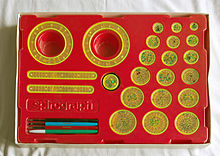Spirograph

Spirograph set (early 1980s UK version)
|
|
| Inventor | Denys Fisher |
|---|---|
| Company | Hasbro |
| Country | United Kingdom |
| Availability | 1965–present |
| Materials | Plastic |
| Official website | |
Spirograph is a geometric drawing toy that produces mathematical roulette curves of the variety technically known as hypotrochoids and epitrochoids. It was developed by British engineer Denys Fisher and first sold in 1965.
The name has been a registered trademark of Hasbro Inc. since 1998 following purchase of the company that had acquired the Denys Fisher company. The Spirograph brand was relaunched with original product configurations in the USA in 2013 by Kahootz Toys and in Europe by Goldfish and Bison.
The mathematician Bruno Abakanowicz invented the Spirograph between 1881 and 1900. It was used for calculating an area delimited by curves. Drawing toys based on gears have been around since at least 1908, when The Marvelous Wondergraph was advertised in the Sears catalog. An article describing how to make a Wondergraph drawing machine appeared in the Boys Mechanic publication in 1913. The Spirograph itself was developed by the British engineer Denys Fisher, who exhibited at the 1965 Nuremberg International Toy Fair. It was subsequently produced by his company. US distribution rights were acquired by Kenner, Inc., which introduced it to the United States market in 1966 and promoted it as a creative children's toy.
In 2013 the Spirograph brand was re-launched in the USA by Kahootz Toys and in Europe by Goldfish and Bison with products that returned to the use of the original gears and wheels. The modern products use removable putty in place of pins or are held down by hand to keep the stationary pieces in place on the paper. The Spirograph was a 2014 Toy of the Year finalist in 2 categories, over 45 years after the toy was named Toy of the Year in 1967.
The original US-released Spirograph consisted of two different-sized plastic rings, with gear teeth on both the inside and outside of their circumferences. They were pinned to a cardboard backing with pins, and any of several provided gearwheels, which had holes provided for a ballpoint pen to extend through them to an underlying paper writing surface. It could be spun around to make geometric shapes on the underlying paper medium. Later, the Super-Spirograph consisted of a set of plastic gears and other interlocking shape-segments such as rings, triangles, or straight bars. It has several sizes of gears and shapes, and all edges have teeth to engage any other piece. For instance, smaller gears fit inside the larger rings, but also can engage the outside of the rings in such a fashion that they rotate around the inside or along the outside edge of the rings. Kenner also introduced Spirotot, Magnetic Spirograph, Spiroman and various refill sets.
...
Wikipedia
